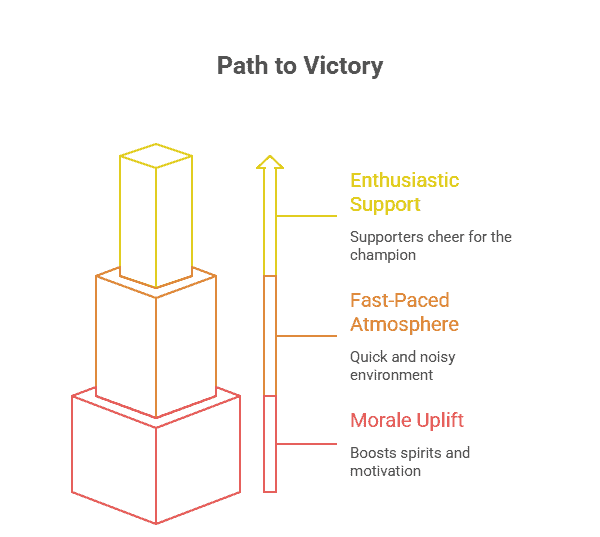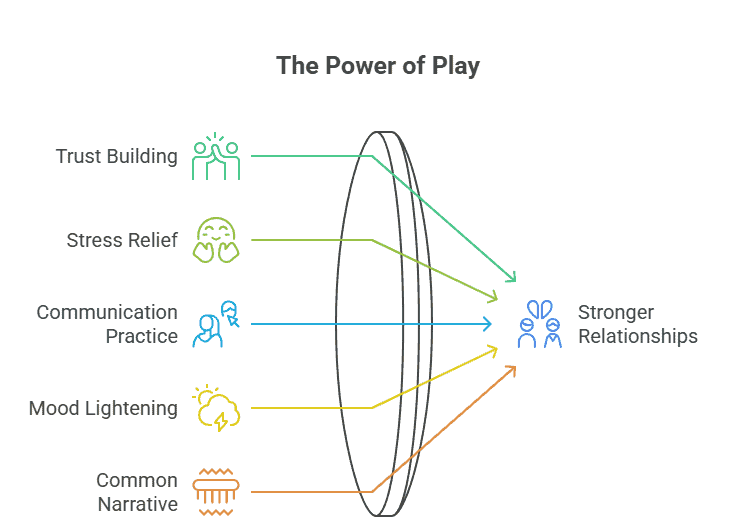Are you in search of games for large groups of all ages that suit living rooms, school gyms, office atriums, and parks with good sunlight? Get going with inclusive icebreakers, throw in one high-energy team challenge, have a collaborative problem-solver among the activities and finish with a short reflection so that “fun” can be a true connection. By merely making some simple adjustments—seated options, sensory-friendly pacing, and clear roles—these activities increase belonging, communication and morale (with just a little friendly competition to make it fun).

Why Playing Together Matters
Shared play can be considered the most successful way to make people trust each other, relieve their stress, and practice communicating, all in a very quiet and rewarding manner. The laughter and problem-solving of family, friends, or co-workers not only demonstrate sympathy but also serve to lighten the mood and build a common narrative—here an inside joke, there a team victory—of which the participants will be reminded long after the snacks have disappeared. This is the main reason why well-chosen games for large mixed-age groups should be one of your resources for home gatherings, community events, and team off-sites.
How to Choose the Right Game (FAST Framework)
F — Fit: Match the game to your group’s ages, mobility needs, culture, and space (indoor vs. outdoor).
A — Aim: Are you breaking the ice, energising, or practising collaboration? Choose accordingly.
S — Scope: Consider group size and time. (Short and simple beats long and confusing.)
T — Tools: Check props/tech. If you don’t have it, swap it—great play doesn’t require fancy gear.
Safety, Inclusion, and Accessibility First
- Physical: Clear hazards, mark boundaries, offer hydration/shade for outdoor play.
- Social: Opt-in participation, rotate roles, celebrate effort over “winning.”
- Accessibility: Provide seated or low-movement variants, quieter break spaces, and visual rule cards.
- Psychological safety: Keep themes neutral and respectful; allow “pass” options without pressure.
Quick-Start Icebreakers (5–10 Minutes)
Air Signature Relay (No Props)
Participants “write” their name in the air (finger, then elbow/knee for silliness). Fast, fun, and zero setup.
Name & Action Loop
Say your name with a simple motion; the group repeats and adds on. Builds laughter and memory quickly.
Common Ground Countdown
Call categories (“loves spicy food,” “has a pet”), and participants form clusters—rapid bonding without awkward small talk.
Facilitator tip: Keep tempo brisk, cue light music, and end while energy is high.
High-Energy Outdoor Classics
Family/Lawn Olympics (Stations Model)
Rotate through sack race, frisbee-putt, water balloon toss, and a relay. Score casually or not at all; the point is participation.
Capture the Flag (Zones & Rescue)
Strategic sprints with “safe zones.” Encourage planning, spotting, and role rotation (runner, defender, scout).
Tug-of-War—Strategy Edition
Teach timing (“3-2-pull”), anchor roles, and even a “silent round” to emphasise nonverbal coordination.
Adaptations: Use softer equipment, widen lanes for mobility devices, and substitute speed-walking for sprinting.
Cooperative Problem-Solvers (Trust + Communication)
Puzzle-Mural Build
Teams create sections of a larger image or message; the final assembly reveals the “big picture.” Great for families and corporate values.
Creative Outdoor Escape
Timed stations with cyphers, mini-tasks, and collaborative clues. Keep puzzles parallel so nobody waits in line.
The Labyrinth of Communication
One partner is blindfolded; the other gives clear verbal guidance through a safe obstacle layout. Swap roles, then debrief on clarity and trust.
Learning targets: concise instructions, feedback loops, and supportive leadership.
Friendly Competition (Clear Rules, Big Laughs)

Giant Jenga with Prompts
Write mini-challenges on blocks (“share a favourite memory,” “two-person balance pose”). Points for steady pulls and bonus tasks.
Rock-Paper-Scissors Ladder
Winners move “up,” supporters cheer their champ. Fast, noisy, and morale-boosting.
Steal the Bacon (Tag-Safe Variant)
Numbered players sprint for a soft object when their number is called; tagging only, no tackling.
Pro move: Post rules on a flip chart, track points visibly, and spotlight good sportsmanship.
Indoor Crowd-Pleasers (Small Spaces, Mixed Ages)
Team Trivia Mash-Up
Combine pop culture with family/company history, then add a wager round for suspense.
Circle of Names Remix
Name + motion, cumulative memory chain. Seated-friendly and hilarious as the sequence grows.
Detective (a.k.a. “Murder in the Light”)
Observation game with visible cues to keep it inclusion-friendly for younger players.
Accessibility: Use microphones in large rooms, print rules for clarity, and use predictable pacing.
Creative & Reflective Cool-Downs
Group Story Weave
Each person adds a sentence (or sketch). Facilitator threads continuity and titles the tale at the end.
Photo Scavenger Narrative
Teams capture images that represent “teamwork,” “kindness,” or “joy.” Run a quick slideshow and short shares.
Gratitude Ring
Invite each participant to appreciate one person specifically. (Yes, tissues have been known to appear.)
Why it works: Calm closure cements connection—and often becomes the memory people mention later.
Hybrid & Virtual Options
- Zoom Trivia Showdown: Breakout teams, live scoreboard.
- Guess the Hum/Whistle: 15–30-second clips, chat guesses, rotating hosts.
- Virtual Scavenger Hunt: Creative prompts (“something that represents your weekend”) with show-and-tell.
Tech tip: Keep rounds short (10–12 minutes), vary activities, and preview instructions on a slide.
Low-Mobility & Sensory-Friendly Variations
- Seated tossing (soft rings/beanbags), tabletop puzzles, collaborative art pieces.
- Agenda slides, visible timers, and designated quiet areas.
- Offer “observer” roles (timekeeper, scorekeeper, photographer) so participation stays truly inclusive.
Sample Plug-and-Play Schedules
60 Minutes (Family Living Room): Icebreaker → Team Trivia → Group Story → Gratitude Ring.
90 Minutes (Workplace Atrium): Energiser → Puzzle-Mural → RPS Ladder → Debrief.
Half-Day (Park): Lawn Olympics → Picnic → Capture the Flag → Reflection Circle.
What This Means for You
When you pair intentional selection with inclusive facilitation, games for large groups of all ages become more than entertainment—they become a relationship engine. Start small, rotate roles so everyone shines, and close with a quick debrief:
- What worked well?
- When did we adapt?
- What will we bring back to home/work/school this week?
Build from there and watch the connection compound over time.
Final Thoughts: From Play to Stronger Relationships
The best games for large groups of all ages blend energy with empathy: a lively opener, a co-operative challenge, a friendly contest, and a reflective finish. That simple arc turns “time together” into trust, inside jokes, and practical communication skills that carry into daily life.
The therapists at Inner Peace Therapies are collaborating with different groups, such as families, couples, teens, and teams, and are thus enabling them to transform their lives through the power of shared experiences. Counselling is provided in person or online for individuals, couples, families, teens, and groups to help them improve communication, reduce conflicts, and restore relationships. If you are curious about changing play into progress, learn how our Illinois therapists can develop a relationship support plan that meets your and your family’s needs at work and everywhere else.





